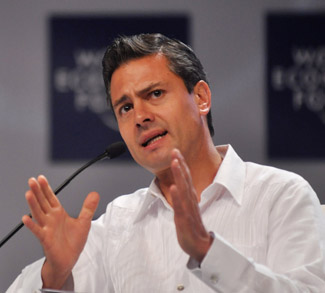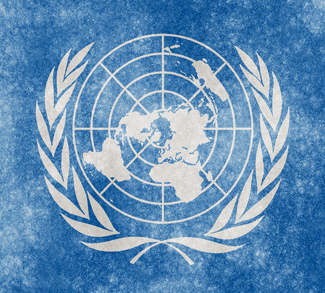On Monday July 15th, 2013, reports were confirmed that operatives of the Mexican Navy, hailed by the United States as the most effective and non-corrupt fighting force in the country, arrested the Zetas’ supreme leader Miguel Angel Treviño Morales, alias “Z-40,” some 17 miles southwest of Nuevo Laredo, Tamaulipas state. As the Zetas are undoubtedly the most ruthless and politically problematic of Mexico’s drug cartels, Treviño’s bloodless arrest has been a cautious PR boon for President Enrique Peña Nieto of the Institutional Revolutionary Party (PRI), who came to office promising a drastic reduction in the violence caused by the counter-insurgency campaign launched by his predecessor of the National Action Party (PAN), Felipe Calderon.
A previous Geopolitical Monitor article profiled the Zetas at some length, going so far as to label them a powerful, cohesive, and sophisticated insurgency engaged in a nuanced campaign of terror aimed at wresting effective control of key Mexican territory from the country’s authorities, and on battling its primary rivals, the Sinaloa Federation, out of the U.S.-Mexico border. Typologically, the Zetas have re-defined the typical narco-trafficking modus operandi. Originally recruited from Mexican Special Forces units trained by the United States and Israel, they started out as the praetorian guard and enforcement force of the Gulf Cartel in 1999, until they split away in 2010—going violently rogue against their original recruiters and establishing a fanatically territorial cartel that extends its influence throughout all of eastern Mexico and south into Guatemala and Honduras. The Zetas’ high profile flaunting of impunity, their politically calculated acts of terroristic brutality upon elements of civil society, along with their astute and savage media manipulation and censorship tactics, have made of this cartel over the years the primary target of the Mexican government’s anti-narcotics efforts. Considering that approximately only 50% of Zeta income is derived from drug smuggling, the rest hailing from kidnappings, paid assassinations, extortions, protection rackets, and human trafficking, it would be correct to categorize the Zetas as a criminal organization that has the requisite muscle to effectively traffic drugs, and not as a drug cartel that was created for the sole purpose of smuggling narcotics. These toughs are guerrilleros first, and narco-traffickers second.
It was not in Treviño’s self-understood persona to construct for himself an aggrandized and legendary personality like the Sinaloa Federation’s “El Chapo,” and such a folkloric feat would have been anomalous in the highly “professional” and impersonal culture of the Zetas cartel. Treviño has, however, perhaps out of sheer natural inclination, come to embody the sui generis paradigmatic shift in narco-trafficker typology that comes with the Zetas’ brand: Fluent in English and well-versed in American customs, he specialized in recruiting young Mexican-American adolescents as “sciarios” (hit-men), and establishing them in safe-houses as sleeper cells all over the United States in order to oversee operations amongst the cartel’s U.S. gangbanger proxies and execute the whims of Zeta justice. Treviño’s singularity stems from his ability to theatrically elevate unto aesthetic spectacle the brutality that other Narcos commit out of strict necessity. Indeed, if Mr. Treviño had had the gift of the quill, he could have greatly elaborated on Thomas de Quincey’s treatise, “On Murder Considered One of the Fine Arts.” He is reputed to have enjoyed boiling babies alive in diesel drums, and of decapitating his prisoners in order to desensitize his young recruits, affectionately termed Zetillas, “little Zetas.” According to Rosalio Reta, one of his teenaged American protégés now serving a 70-year sentence in a Texas solitary confinement facility, Treviño would suffer severe insomnia if he didn’t kill someone or something on any given day. Furthermore, in his recreational random killings, which he often directed from his armored vehicle while patrolling his territory by pointing his finger at “that one,” or “this one,” he felt the need to be aesthetically titillated by the victim in order to derive some measure of fun from the slaying.
His paramilitary mettle was proved in 2005 when he was made the Zetas’ regional commander of the Nuevo Laredo, Tamaulipas state plaza, back when the Zetas were still under the employment of the Gulf Cartel. He was charged with battling the Sinaloa Federation’s attempts to gain access to the I-35 corridor, pitting the two cartels in a titanic rivalry that persists to this day. Securing control of northeastern Mexico’s drug lands, Treviño expanded his operations to include immigrant smuggling, extortions and kidnappings, thus departing from established parameters of Narco activities. Some two years after completing his tour of duty in Tamaulipas, in 2008 Trevino won the admiration of then-Zeta boss Heriberto Lazcano Lazcano when he successfully secured trafficking routes in Guatemala after a deadly incursion into that country in which he reportedly killed the Guatemalan crime boss Juan Jose Leon Ardon.
Though Treviño could be considered a grandiose figure within the cartel leading up to his ascension to the leadership in 2012, this trend ran contrary to a key strength of the Zetas organization- its impersonal nature and rigidly defined hierarchical structure, both of which have historically made leadership transitions run more smoothly than in other cartels. Members rise in rank by merit and not familial connections, a marked difference from the internal culture of other cartels, including the Zetas’ chief rival, the Sinaloa Federation. This mentality has been reinforced by the original’s military training and martial culture, which has engendered in the cartel’s captains a sort of respectful deference that has contributed to keeping together an oftentimes-fragile corporate cohesion. Treviño himself was not former military, so it remains to be seen if the organization’s internal dynamics have altered in any way as a result of his tenure. His own brother, Omar Treviño, a high-ranking operative, is widely considered to be a contender for the open leadership position.
It is undeniable that the United States is more than ambivalent towards the direction the Mexican administration has taken in its struggle against narco-traffickers. The PRI and its traditional nationalistic prejudice against foreign encroachment on matters of state security, along with that party’s desperate desire to re-establish its hegemonic imperium by capitalizing on the electorate’s weariness of a now-stratospheric death toll, have led to Peña Nieto’s call for a new strategy, the goal of which is not a large-scale interdiction of narcotics and the capture or killing of drug lords, as the U.S. wants, but rather an amorphous and politically expedient platitude of “reducing violence.” During the presidential campaign and his first months in power, Peña Nieto promised to de-militarize the war by creating a civilian paramilitary gendarmerie along Colombian lines, and though he has appointed former Colombian general Oscar Naranjo as his security adviser, the proposed force’s status remains, and is likely to remain, in limbo. As the country’s economy grows at an impressive annual rate of approximately 3.8%, the unprecedented violence unleashed during the previous presidential administration has not abetted in any real way. In fact, in many parts of Mexico it is spreading and increasing, becoming more uniform throughout the country, even though various cartels’ territorial lines have remained largely static.
Complications in U.S.-Mexican Cooperation: The Intelligence Dilemma
On December 15, 2012, two weeks after Peña Nieto was sworn-in as the new president, a tense and premonitory meeting took place at the U.S. embassy in Mexico City between the new government’s national security team, including the new interior minister, attorney general, and various Mexican intelligence officials, and agents of the FBI, CIA, DEA, as well as representatives from the State Department and the Office of the Director of National Intelligence. Maintaining a subtle calmness, the scandalized Mexican grandees were briefed on the extent of U.S.-Mexico cooperation in the hemispheric struggle to stem the tide of narcotics into American streets. The Mexicans were informed that as the violence escalated in quantity and degree, the two countries’ partnership and fierce determination also deepened. By 2011, there was an intelligence fusion center run by the CIA in Mexico City, one run by the DEA in Monterrey, Nuevo Leon, as well as massive American infrastructure development inside CISEN, the Mexican intelligence agency. While American spies aided the various branches of the Mexican military in real-time during raids and intelligence gathering expeditions, U.S. spy planes were given full rights to patrol the skies, and unarmed drones provided Mexican Special Forces with information on the daily patterns of activity of targeted kingpins and their henchmen. To stem the constant threat of cartel intelligence agents’ penetrating the Mexican security services, the CIA’s then-classified program SCENIC was training the Mexicans on vetting methods, as well as on successful asset recruitment. President Calderon had come to rely so much on drones, that he decided to not only purchase some, but also asked the U.S. for armed drones to strike at the traffickers, a request that was turned down due to the immense political risk of collateral damage in politically volatile Mexico. President Calderon had also given U.S. agents the rather exceptional privilege of actually choosing which branches of the Mexican military, and further, which units, received the actionable intelligence, thereby also implicitly agreeing to the Americans’ assessment of the reliability (read incorruptibility) of specific units and officers.
Four months after the abovementioned meeting, President Peña Nieto’s team delivered the first changes to the U.S.-Mexico anti-drug efforts. The PRI appointees declared that Americans would no longer be allowed to work inside the intelligence fusion centers, and that direct communication between civilian CIA and DEA agents and their contacts in the Mexican military was now prohibited. All intelligence purveyed by Americans must go through the Interior Ministry, and only after that can the director of CISEN transmit the information to those he sees fit. Suffice it to say, such procedural changes bode ill for the future of the Narco War in Mexico. The United States has responded that while the Mexican administration has every right to consolidate the flow of information and limit the presence and agency of American intelligence personnel in their country, the U.S. was also at liberty to withhold intelligence it gathers when it fears it would simply be put to ill or unreliable use.
The Transition from Calderon to Nieto: Different Styles, Changing Policies?
Former President Calderon is what in American political parlance is typically called a policy wonk. He not only understood the various conceptual theories in play in his personal crusade against the narco-terrorism plaguing his country, but he also possessed a truly impressive mastery over the details of the war. He absorbed the genealogical and statistical information about the various cartels, the death toll figures, the national criminal geography, and was able to eloquently expound upon the intricacies of the criminal alliances and his government’s many efforts against them. His rhetoric was unequivocal and tinged with a political morality that treated narco-terrorism as a national threat that needed to be rooted out with the historical ferocity of Mexican patriotism. The traffickers he captured were cuffed and paraded, along with their weapons caches and merchandise seizures, before news cameras, showing them on prime-time television as enemies of the Mexican Republic, flanked with heavily armed and ominous-looking masked military men.
President Peña Nieto, on the other hand, is not a man known for being particularly engrossed in any form of data whatsoever, and he self-identifies as a man of concepts and broad paradigms rather than details. His political style makes lavish use of rhetorical flourishes, and he knows how to capitalize on his and his wife’s telegenic personalities, as his wife is a former soap opera actress. Although he understands the power of images, with the exception of very few instances, he has abandoned his predecessor’s custom of parading the arrested criminals before television cameras, and has largely stopped the official use of the traffickers’ rather colorful call signs. To illustrate this salient point, the recently captured Zeta boss was photographed as he was escorted into the PGR building un-handcuffed, uprightly striding along with a haughty air of condescension. The official explanation for this was that the administration was trying to be “very respectful towards everyone’s rights.”
While Peña Nieto’s detractors are rhetorically flaming the fires of a possible Faustian bargain with the criminal organizations as was the case in El Salvador, it is amply clear that any new and nuanced Pax Mafiosa would have to be established only after the state reconsolidated its undisputed sovereignty over the entirety of the Mexican territory. During the seven decades of the PRI’s “perfect dictatorship,” the bureaucratic state certainly held the upper hand over the largely deferential drug traffickers. The party’s nationally hegemonic apparatus included a tight policy of how to deal with them, recognizing that as long as there was demand, there would be supply. The police and politicians kept a stern and beneficial watch over the criminal organizations, and when any thug exceeded the bounds of established propriety, he would be taken in. This system broke down after the introduction of democracy under President Vicente Fox, and the chaos was stirred for the eventual necessity of military action under President Calderon. Thus, from a purely analytical standpoint, in order to reap any benefit from a Narco-truce, the state must finish re-asserting itself as sovereign, or else it will be a gesture done in vain. In 2009 the U.S. Joint Forces Command grimly stated that “In terms of worse-case scenarios for the Joint Force and indeed the world, two large and important states bear consideration for a rapid and sudden collapse: Pakistan and Mexico.” Although this statement was made only four years ago, Mexico is no longer so precariously placed as to warrant such a suggestion. It is, however, a testament to the utter devastation and loss of control the various authorities in Mexico suffered in the first phase of the Narco War, and the Mexican state is not altogether in the clear, yet.




